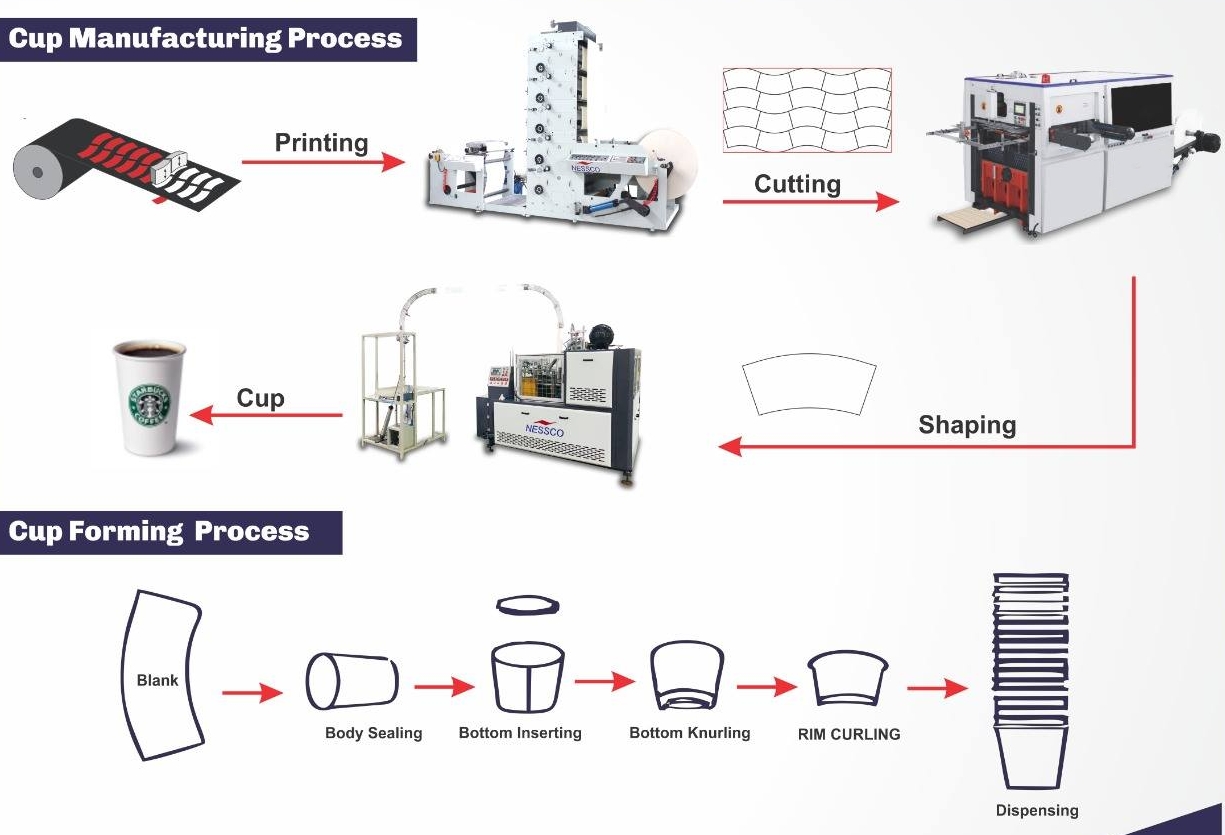Je výroba papírových kelímků udržitelná?
Průvodce výrobou papírových kelímků
Oddíl 1: Pochopení základů výroby papírových kelímků
V této části se budeme zabývat hlavními materiály používanými při výrobě papírových kelímků a procesem jejich výroby.
Jaké jsou hlavní materiály používané při výrobě papírových kelímků?
Papírové kelímky jsou vyrobeny z kombinace materiálů, včetně papíru, potahové látky a přísad. Hlavní materiály používané při výrobě papírových kelímků jsou:
- Karton: Papírové kelímky jsou obvykle vyrobeny z potravinářské lepenky pocházející z šetrných lesů. Karton dodává kelímkům strukturu a pevnost.
- SBS Pulp: SBS (pevná bělená sulfátová) buničina je klíčovým materiálem používaným v papírové vrstvě. papírové kelímky. Buničina SBS pochází z odpovědně obhospodařovaných lesů a je udržitelná a potravinářská.
- Povrchová úprava: Povlak na vnitřní straně papírových kelímků je obvykle vyroben z plastu, například z polyethylenu (PE) nebo kyseliny polymléčné (PLA). Povlak zabraňuje prosakování tekutiny a umožňuje šálky vhodné pro uchovávání horkých i studených nápojů..
- Přídatné látky: Přísady, jako jsou barviva a chemické látky, se používají ke zlepšení vlastností papíru a nátěrových hmot. Tyto přísady zajišťují, že kelímky jsou hygienické, trvanlivé a odolné vůči teplu.
Jak probíhá proces výroby papírových kelímků?
Na stránkách výroba papírových kelímků proces zahrnuje několik kroků, od přípravy dužiny až po formování pohárů. Zde je přehled celého procesu:
Úloha buničiny SBS při výrobě papírových kelímků
V procesu výroby papírových kelímků hraje zásadní roli buničina SBS. Jedinečné vlastnosti SBS buničiny, jako je její pevnost a schopnost držet tvar, z ní činí jedinečnou surovinu, která je vhodná pro výrobu košíčků. ideální materiál pro papír vrstva šálku. SBS buničina se před použitím při výrobě šálků bělí, aby se dosáhlo požadovaného jasu a čistoty.
Rozvlákňování a bělení: od buničiny k šálkovým polotovarům
Proces výroby papírových kelímků začíná rozvlákněním a bělením SBS buničiny. Buničina se smíchá s vodou, čímž vznikne kaše, která se poté vaří v kádi pod širým nebem, aby se rozložila vlákna a odstranily nečistoty. Vzniklá buničina se filtruje, pere a bělí, aby se dosáhlo požadované barvy a čistoty.
Jakmile je dužina hotová, vyrábí se z ní polotovary šálků. Polotovary pohárků jsou velké listy lepenky, které se později rozřežou, vytvarují a zformují do pohárků. Buničina se rovnoměrně rozprostře na pásový dopravník s drátěným pletivem a přebytečná voda se odsaje. Poté se buničina lisuje a suší, aby se dosáhlo požadované tloušťky a vlhkosti.
Techniky tvarování pohárů: Způsoby skládání a těsnění
Po přípravě polotovarů pohárů se tyto poháry tvarují do finální podoby. Tvarování pohárků zahrnuje složité procesy skládání a utěsňování. Polotovary pohárků se vloží do stroje na tvarování papírových pohárků, který papírovou lepenku obtočí kolem trnu a vytvoří tak charakteristický válcový tvar pohárku. Poté stroj lepenku utěsní lepidlem, aby pohárek udržel svůj konečný tvar.
Nastavením výšky a průměru trnu ve tvářecím stroji lze vyrábět různé velikosti papírových kelímků. Jakmile jsou kelímky vytvarovány, projdou procesem řezání, při kterém se odstraní přebytečná lepenka a získá se hladký okraj. Provádějí se kontroly kvality, aby se zajistilo, že kelímky splňují požadované normy pro zabránění úniku a celkovou kvalitu.
Závěrem lze říci, že při výrobě papírových kelímků se používají klíčové materiály, jako je SBS buničina, lepenka a plastové povlaky. Proces zahrnuje rozvlákňování, bělení, tvarování kelímků a kontrolu kvality. Pochopení základů výroby papírových kelímků nám pomůže ocenit řemeslnou zručnost a postupy udržitelnosti, které stojí za tímto základním předmětem každodenní potřeby.
Další díl série: Sekce 2: Postupy udržitelnosti při výrobě papírových kelímků.
Oddíl 2: Postupy udržitelnosti při výrobě papírových kelímků
Proč je udržitelná výroba při výrobě papírových kelímků klíčová?
Začlenění tabulek pro vizualizaci dat z tohoto příspěvku na blogu
Časté dotazy týkající se výroby papírových kelímků
Jaké jsou hlavní materiály používané při výrobě papírových kelímků?
Odpověď: Pro pochopení klíčových materiálů používaných při výrobě papírových kelímků se zabýváme lepenkou, SBS buničinou, nátěrem a přísadami.
Jak probíhá proces výroby papírových kelímků?
Odpověď: Proces výroby papírových kelímků obvykle začíná přípravou buničiny, tvarováním polotovarů kelímků a použitím technik tvarování kelímků.
Proč je udržitelná výroba při výrobě papírových kelímků klíčová?
Odpověď: Udržitelná výroba má zásadní význam pro minimalizaci dopadu na životní prostředí a podporu ekologických postupů při výrobě papírových kelímků.
Jaké jsou budoucí trendy ve výrobě ekologických papírových kelímků?
Odpověď: Klíčovými trendy v ekologické výrobě papírových kelímků jsou zkoumání materiálů z odpovědných zdrojů, udržitelné výrobní postupy, biologicky rozložitelné nátěry a přísné kontroly kvality.
Jaké faktory ovlivňují náklady na výrobu papírových kelímků?
Odpověď: Při analýze nákladových faktorů ovlivňujících výrobu papírových kelímků je zásadní porozumět surovinám, spotřebě energie, mzdovým nákladům, objemu výroby a kontrole kvality.
Závěrem bychom chtěli říci, že zkoumal výrobní proces papíru šálků, od materiálů až po udržitelnost. Udržitelné postupy a nákladové faktory hrají zásadní roli v budoucnosti tohoto odvětví. Klíčové je zavádění ekologických strategií a sledování trendů na trhu. Nezapomeňte, že výběr materiálů z odpovědných zdrojů a zavádění inovativních technik může utvářet udržitelnější průmysl papírových kelímků. Zůstaňte informovaní, buďte napřed!




